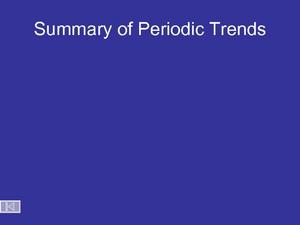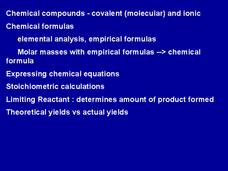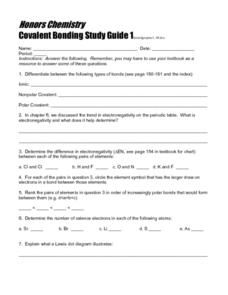Curated OER
2000 U.S. National Chemistry Olympiad Local Section Exam
This 60-question comprehensive exam was designed to determine who would go on to compete in the 2000 US National Chemistry Olympiad. Hopefuls answer multiple choice questions regarding all chemistry topics taught in the first year...
Curated OER
Science Puzzlers, Twisters, and Teasers: Chemical Bonding
What a cute approach to chemical bonding! Atoms all have human names and are attending at a dance. Who will pair up with whom? By reading the characteristics, and not the element name, chemistry whizzes figure out the bonding pairs....
Kenan Fellows
What Element Would You Be?
Primo Levi wrote a collection of short stories comparing his life from Italy to Auschwitz to elements in the periodic table. Pupils read an excerpt from his book and research the characteristics of various elements. Then, they make a...
Royal Society of Chemistry
Electronegativity Values
Finally, an electronegativity resource your class will be strangely drawn to! Skilled scientists manipulate interactive puzzles to gain an understanding of common electronegativity values. The great thing? You can conduct the lesson...
National Institute of Open Schooling
General Characteristics of the p-Block Elements
The 20th installment in a series of 36 focuses on the characteristics of the p-block elements. Learners discuss, read about, and answer questions pertaining to the occurrence of these elements in nature, their electron configurations,...
Science Geek
Periodic Trends
If your pupils think Um is the element of confusion, this presentation on period trends can only help. It covers the patterns for atomic radii, ionization energy, and electronegativity across a period and down a group.
Curated OER
Ranking Molecular Properties Based Upon Intermolecular Forces
A splendid chart of information about chemical bonding tops the first page. In it you will find information on London forces, permanent dipoles, hydrogen bonds, ionic bonds, and covalent bonds. A four-step process for assigning...
Curated OER
Bond Type
At the top of the page are a reading passage and colorful diagram that depicts the tug-of-war that occurs between bonding molecules due to electronegativity. High school chemists fill in a chart with electronegativity values, the...
Curated OER
8.4 Section Review ~ Polar Bonds and Molecules
A very neat worksheet has been produced by Pearson Education, Inc. for use in a general chemistry class. The first nine questions are fill in the blanks for a paragraph about types of bonds and electronegativity. Five true-false...
Spark Notes
Review of Chemical Bonding: Review Test
This is an online exercise in which chemistry learners answer a series of multiple choice questions about bonding. Topics addressed include ionic and covalent bonds, electronegativity, ions, valence electrons, resonance structure, and...
Curated OER
Summary of Periodic Trends
This concise collection of images speaks volumes about the trends in the periodic table of elements. Different versions of the periodic table are displayed demonstrating different trends. Teachers' notes are included to assist your...
Curated OER
Chemical Compounds
Your young chemists will find these slides very informative. Groups and periods of the periodic table are labeled and described according to the charge. Comprehensive explanations of physical and chemical properties and how they relate...
Curated OER
Periodic Trends
Chemists compare the electronegativity, ionization energy, electron affinity, and ionic radius of different elements. This worksheet is composed of 11 multiple choice questions, and 8 written explanations. Critical thinking skills are...
Curated OER
The Periodic Table
A huge collection of slides introduces chemistry learners to the periodic table of elements, electron configuration, and electronegativity. It opens with the history of today's periodic table, and then details the arrangement. After...
Curated OER
Periodic Trends
Thorough explanations of the trends in the periodic table of elements make up the majority of this handout. Atomic and ionic size, ionization energy, electron affinity, and electronegativity are presented before giving chemistry...
Curated OER
Polyatomic Ions
Opening with a chart of common polyatomic ions, and finishing with an explanation of how to name polyatomic ions, this presentation is to the point. The links on the vocabulary page do not work, leaving you only a few slides to work...
Curated OER
How Do Atoms Stick Together?
In this chemical bonding worksheet, learners answer 76 questions about compounds, Lewis dot structures, intermolecular forces between atoms, electronegativity and bonding and types of bonds.
Curated OER
Electonegativity-How Do Atoms Stick Together?
In this electronegativity worksheet, students use given electronegativity values for each element to determine the bond type in 9 molecules.
Curated OER
Trends in the Periodic Table
In this trends in the periodic table instructional activity, high schoolers plot the ionization energy vs. atomic number and they plot atomic radius vs. atomic number of the first 20 elements. Students analyze their graphs and answer...
Curated OER
Electronegativity
For this electronegativity worksheet, learners complete a chart given 10 molecules. They draw their Lewis structures, they draw the shape of the molecule, they determine the difference in electronegativity between the bonds, they...
Curated OER
Periodic Table Quiz Review Sheet
In this periodic table worksheet, learners answer 10 questions about electronegativity, the groups of elements, atomic radius trends, electronegativity trends, ionization energy trends and properties of the elements.
Curated OER
Intermolecular Forces
In this intermolecular forces activity, students perform a simple experiment with water to observe the intermolecular forces that hold water together as they fill a beaker as much as possible. They explain the results of their...
Curated OER
Honors Chemistry-Covalent Bonding Study Guide I
In this covalent bonding worksheet, students answer questions about types of bonds, electronegativity, valence electrons, and Lewis dot structures. They answer specific questions about covalent bonds in molecules and explain the...
Curated OER
Laboratory: Modeling Molecular Shapes
In this molecules worksheet, students answer post lab questions about types of bonds, factors that determine polarity and molecular geometry. They calculate electronegativity differences in atoms and determine the types of bonds between...

























